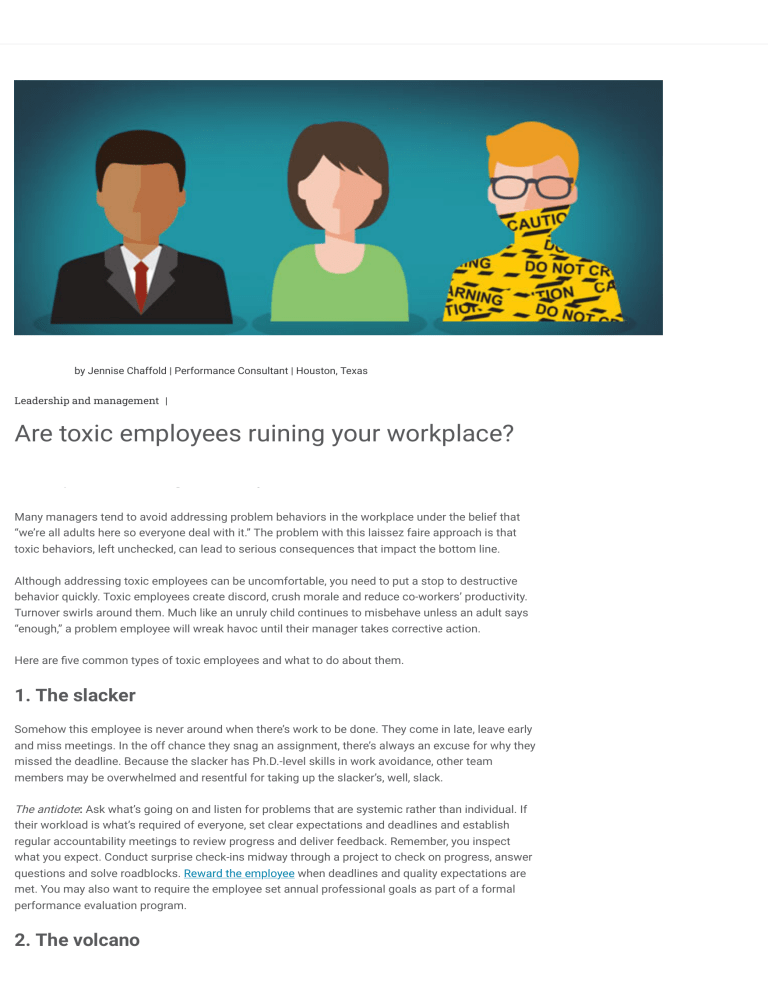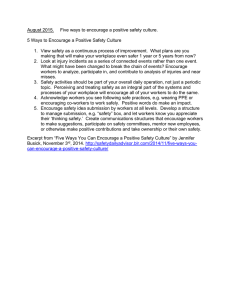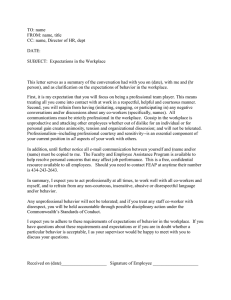
View Insperity’s updated COVID-19 Resource Center. Partner with us Resources Investor relations Careers Locations by Jennise Chaffold | Performance Consultant | Houston, Texas Leadership and management | 1 Comment Are toxic employees ruining your workplace? Get up-to-date HR insights sent to your inbox Many managers tend to avoid addressing problem behaviors in the workplace under the belief that “we’re all adults here so everyone deal with it.” The problem with this laissez faire approach is that toxic behaviors, left unchecked, can lead to serious consequences that impact the bottom line. Although addressing toxic employees can be uncomfortable, you need to put a stop to destructive behavior quickly. Toxic employees create discord, crush morale and reduce co-workers’ productivity. Turnover swirls around them. Much like an unruly child continues to misbehave unless an adult says “enough,” a problem employee will wreak havoc until their manager takes corrective action. Here are five common types of toxic employees and what to do about them. 1. The slacker Somehow this employee is never around when there’s work to be done. They come in late, leave early and miss meetings. In the off chance they snag an assignment, there’s always an excuse for why they missed the deadline. Because the slacker has Ph.D.-level skills in work avoidance, other team members may be overwhelmed and resentful for taking up the slacker’s, well, slack. The antidote: Ask what’s going on and listen for problems that are systemic rather than individual. If their workload is what’s required of everyone, set clear expectations and deadlines and establish regular accountability meetings to review progress and deliver feedback. Remember, you inspect what you expect. Conduct surprise check-ins midway through a project to check on progress, answer questions and solve roadblocks. Reward the employee when deadlines and quality expectations are met. You may also want to require the employee set annual professional goals as part of a formal performance evaluation program. 2. The volcano Subscribe Search Sign in You never know with the volcano. They smolder and rumble quietly for days or weeks, then blow. These employees may have a hair-trigger temper or dissolve into tears under the slightest pressure. with us Resources Investor relations Either behavior makes those around them uncomfortable and disruptsPartner the workplace. Worst case scenario: The volcano loses it with a customer, damaging your company’s reputation. The antidote: Talk to the employee privately to find out what’s going on. Is this typical behavior for the person or a one-off? Focus on the behavior and give tangible examples of how their behavior negatively impacts the workplace. The person may not realize that their volatility makes other employees feel bullied or that people are avoiding working with them because of it. If the overly emotional employee has problems at home, recommend they use your company’s EAP (employee assistance program). If it’s a persistent problem, consider placing them on a performance plan for improvement. HR may need to be part of these conversations to document what’s said and done should this behavior not improve or become more severe. 3. The martyr At first glance, having a martyr on staff may seem like a good thing. They say yes to every project, and no deadline is impossible. But take a closer look. The martyr may prevent others from learning new skills because they soak up all new opportunities or refuse to delegate. They may come to work sick and infect others. Hypercompetitive and controlling, they demotivate co-workers who feel they can’t beat someone who’s willing to say yes to anything and work 24/7. The antidote: Be aware of workloads and plum assignments. Make sure projects are spread out fairly among your team members. Be prepared to explain why the martyr isn’t getting all the hardest jobs. Consider giving this person a special project or two to feed their needs without disrupting the normal workflow. If this person is a manager, encourage him or her to delegate. This can be especially hard for martyrs, so coach them on good delegation techniques. Talk with employees about work-life balance and insist they take vacation. Make sure they fully disconnect from work, including their physical presence and email. 4. The pessimist Ah, the office pessimist. The pessimist moves through the office like a black cloud, dumping rain on everyone else’s picnic. Every client is a hassle, every assignment is boring, every new idea surely will bring the walls tumbling down. They spread suspicion and doubt, sapping joy and creativity from the workplace. The antidote: Everyone feels negative about a project or a customer occasionally. But don’t let a perpetual pessimist stay in the habit of disagreeing, criticizing or whining. Like the slacker or the volcano, focus on the behavior, explain why it’s a problem and be specific with examples and suggestions for improvement. The pessimist may not realize their impact on others. Consider teaching them the “sandwich” technique so that when they’re giving feedback, they provide a positive comment first, then constructive feedback, then end on a positive note. 5. The bully Somewhere on the path to adulthood, bullies learned their aggressive tactics worked. They evolve from taking lunch money in childhood to picking on co-workers as adults. They belittle and insult. They manipulate situations to make others look bad. Bullies especially enjoy positions of power, so they may trample others to get a more visible and responsible position. The antidote: It’s your job to stop this most destructive of employees in their tracks. If you spot one of your supervisors yelling, insulting or stepping into an employee’s “personal space”, react immediately. Get security to escort the individual to HR immediately. Don’t try to handle this volatile person alone. In your employee handbook, clearly outline your zero tolerance policy for this type of behavior. On the less extreme end of the bully scale, for example a snide comment about someone else’s suggestion in a meeting, simply state that everyone’s ideas are valued and ask for more details on the idea. Calmly explain why this behavior will not be tolerated. Careers Locations Search Sign in Be willing to look inward View Insperity’s updated COVID-19 Resource Center. Partner with us Resources Investor relations It may be easy to label destructive behaviors, but don’t fall into the trap of thinking it’s all your workers’ fault. Most employees want to get along with their co-workers and contribute in a positive Careers Locations manner to their workplace. Rarely will you come across the extreme: An employee so emotionally damaged that there’s just no coaching them to productivity. You leave this toxic person in place at your company’s peril. Such extremists cause severe loss of productivity, high turnover, lost clients and charges of discrimination or harassment. What’s much more common is systemic toxicity caused when a leader lets bad behavior go unchecked for months or years. In such cases, teams fall into a kind of negative feedback loop, accustomed to low productivity and sour feelings about their co-workers. Be prepared to coach the toxic employee “up or out,” as soon as you spot a problem behavior. Most employees can be guided to better productivity and more positive work relationships. You, as their leader, just need to act quickly and decisively. Fast action accomplishes two things: It lets the whole team know that you’re holding everyone accountable. And you stop toxic employees before they completely destroy their own credibility or their team. If you need help knowing what to say or do when coaching toxic behavior, download our free e-book, A practical guide to managing difficult employees. Leave a comment 1 Comment by Karen Cavanaugh-Schroder | Senior Human Resource Specialist | Chicago, Illinois Leadership and management | 0 Comments Managing remote teams: 9 tips to handle difficult conversations over distances Get up-to-date HR insights sent to your inbox Subscribe Search Sign in


